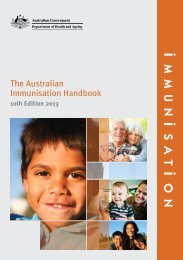Contents Chapter Topic Page Neonatology Respiratory Cardiology
Contents Chapter Topic Page Neonatology Respiratory Cardiology
Contents Chapter Topic Page Neonatology Respiratory Cardiology
Create successful ePaper yourself
Turn your PDF publications into a flip-book with our unique Google optimized e-Paper software.
) Changing of Ventilator settings:<br />
1. To produce an increase in pO2 either: -<br />
a) Increase FiO2 concentration.<br />
b) Increase PEEP.<br />
c) Increase PIP (increases minute volume).<br />
d) RARELY Increase I/E ratio (prolong inspiration)<br />
2. To produce a decrease in pCO2 either: -<br />
a) Increase Rate (increases minute volume)<br />
b) Decrease I/E ratio (prolong expiration)<br />
c) Increase PEEP in worsening lung disease. Decrease PEEP in<br />
recovery phase.<br />
3. Do the opposite to decrease paO2 or to increase paCO2.<br />
Minute volume = tidal volume (volume per breath) x rate per minute<br />
With volume-limited ventilators minute volume can be calculated (use tidal volume = 4-6<br />
ml/kg)<br />
With pressure-limited respirators - increasing peak inspiratory pressure results in increased<br />
minute volume.<br />
e) Sedation and Ventilation<br />
Avoid paralysing the child (e.g. with pancuronium) as far as possible. Paralysing<br />
has been shown to result in poorer lung function and other complications.<br />
Use morphine infusion or intermittent bolus as an analgesia and sedative.<br />
d) Complications of ventilation<br />
Consider the following if the child deteriorates on ventilation:<br />
ETT Dislodged;<br />
Obstructed.<br />
Pneumothorax<br />
Esophagus position<br />
Ventilator tubes disconnected.<br />
Ventilator malfunction<br />
Intraventricular Haemorrhage<br />
Worsening of the primary condition.
















